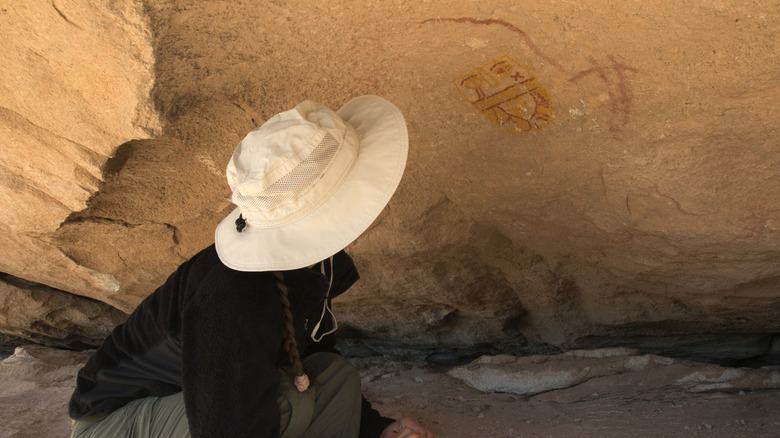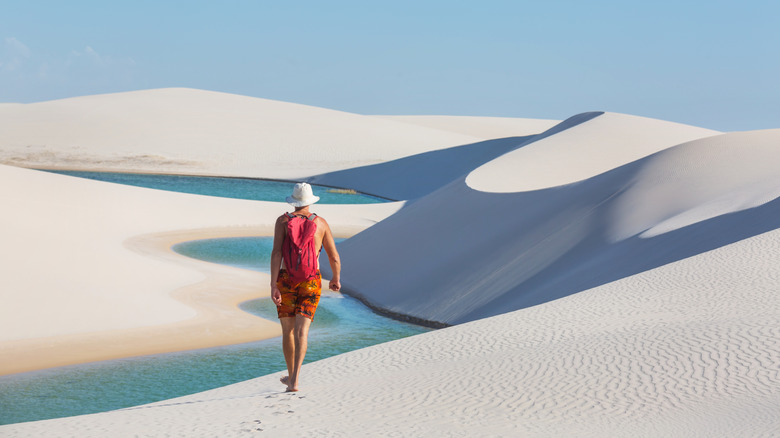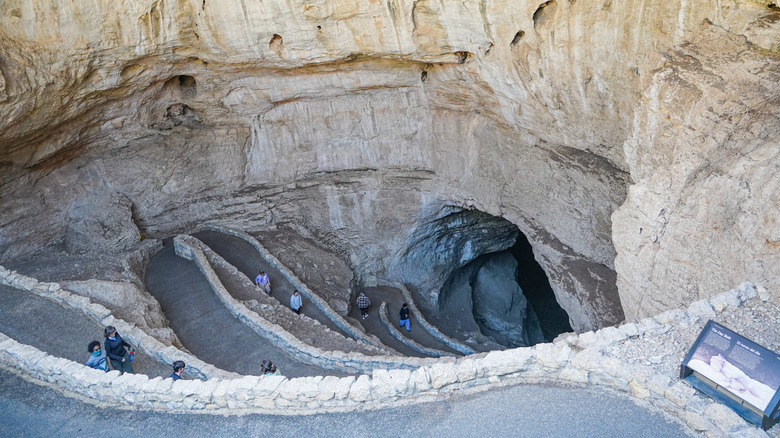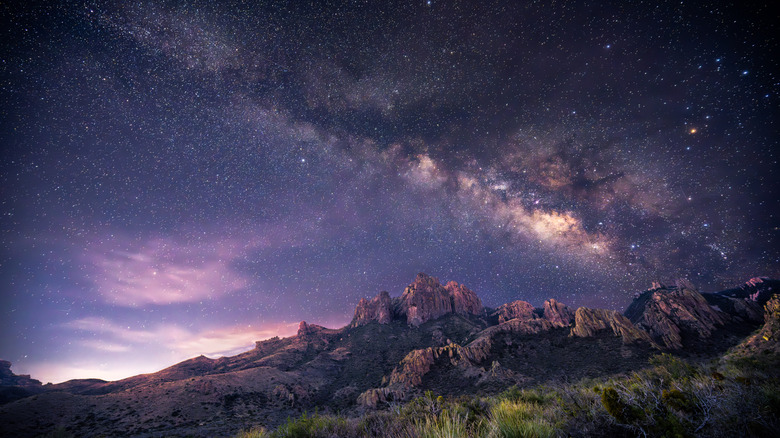
Trying to figure out the most stunning and storied route for your perfect U.S. road trip? You're in luck, because when it comes to road trips, the country offers a plethora of choices for the discerning traveler. Whether you're embarking on the ultimate historic cross-country road trip through America's most iconic sites
or are simply in it to visit quaint towns between points A and B, the call of the open road guarantees epic and unforgettable adventures.No road trip offers a more sensational route
through the Southwest's most stunning parks than this famous Texas-New Mexico loop. This road trip kicks off from El Paso, the sun-drenched westernmost point of Texas and a melting pot of American and Mexican influences that have vibrantly shaped its people, culture, customs, and food. This diversity extends to the dramatic landscapes along the border, where a collection of state and national parks reveal a wealth of natural sites spanning caves, canyons, sand dunes, and mountains on one epic journey.
Read more: The 5 Best Hidden Hot Spring Hikes In California
Hueco Tanks State Park And Historic Site, Texas

The unique rock formations of Hueco Tanks State Park are owed to the cooled magma that had pushed its way into old limestone, chipped and worn away by the elements over millions of years. The hollowed basins — huecos — emerged from the rock surfaces, pooling rainwater that served as a precious water source for the people and animals traveling through the Chihuahuan Desert.
"What makes Hueco Tanks special is that the Hueco mountains are an oasis in the desert," says Cassie Cox, park superintendent of Hueco Tanks State Park and Historic Site, said in a video from the Texas Parks and Wildlife YouTube channel. "And so because of that, people have been visiting this park for 10,000 years." Traces left by these ancient hunter-gatherers called Jornada Mogollon, dating back to 1150 A.D., appear in the form of painted pictographs around the park, which can be visited with a guide or independently, though a ranger-guided tour grants you access to areas closed to the public.
There's plenty to do and see outside the stone carvings the park is famous for. Boulderers and rock climbers gravitate toward the park's rock formations, and the trails and bird-watching opportunities beckon explorers seeking a slice of an authentic Chihuahuan Desert experience. Just a 40-mile drive from El Paso with a modest entrance fee of $7 for anyone above 13 years old, this state park packs together geological and historic wonders.
White Sands National Park, New Mexico

Two hours north of Hueco Tanks is White Sands National Park, which protects 40 percent of the 275 square-miles of dazzling white gypsum dunes in the Chihuahuan Desert. The grains of gypsum "sand," a unique dissolvable mineral whose reflective surface appears bright white under the sun, stays cool to the touch under the scorching sun due to its heat-resistant properties.
Allow yourself to bask in the park's otherworldly landscape by traversing the 8-mile (16 miles round trip) Dunes Drive, which traces a path from the park's Visitor's Center toward the dune fields and back. If hiking is up your alley, there are trails suited to any fitness level, from short but sweet walks along the Interdune Boardwalk to the more challenging 5-mile hike up the Alkali Flat Trail — surprisingly steep and not at all flat — to one of the park's highest dunes. Skim down the dunes on sleds, which can be purchased ($25) or rented ($15) at the Visitor's Center. Sledding is best done from the Roadrunner Picnic Area or the Alkali Flat Trailhead.
But it is at golden hour and beyond that the park works its magic on visitors. During the spring (May to October), the park extends its opening hours to host Full Moon Nights, whose program includes concerts or ranger presentations under the dreamy night sky. In the fall, rangers can walk you through the white sand dunes under the moonlit sky. As White Sands is smaller than other U.S. National Parks, a day's visit will suffice.
Carlsbad Caverns National Park, New Mexico

A three-hour drive from White Sands National Park is Carlsbad Caverns National Park, a UNESCO World Heritage Site — one of only 26 such designated sites in the U.S. Beneath the diverse ecosystem of the Chihuahuan Desert — a rich landscape of canyon ridges, desert woodlands, and a vast plant life of cacti, sunflowers, and grasses — is a network of more than 119 caves, gradually carved into existence by sulfuric acid eating away at limestone over millions of years.
The Big Room Trail is a 90-minute walk (on average) through flat terrain that takes you to the largest accessible cave chamber in North America hidden in the Guadalupe Mountains. A shorter route is also available, cutting the 1.25-mile trail to 0.6 miles. If you aren't up to the descent, an elevator takes you directly to the cavern. A 62-foot tall stalagmite, a stalactite cluster forming a chandelier, and other intricate geological formations decorate the expansive subterranean landscape. A more challenging route — the Natural Entrance Trail — traces a steep descent 75 stories (750 feet) below ground. The air is cooler in the caves, so come with a light jacket. Come May through October, you can witness swarms of bats exiting the caves at sundown for their evening hunt. Reservations are highly encouraged.
Guadalupe Mountains National Park, New Mexico

Just 30 minutes away by car from Carlsbad Cavern is the hiker's paradise of Guadalupe Mountains National Park. Skirting Southeastern New Mexico and West Texas, the park embraces a range of trail difficulties and elevations for the amateur and advanced hikers. Timing your trip to the park depends on the weather. Favoring fall and spring offers the best conditions for treks through the national park, where you're less likely to encounter scorching hot days, rainstorms, and winter snowfall.
The fall foliage is a majestic sight, rewarding McKittrick Canyon hikers with a pastiche of reds, yellows, and browns of the bigtooth maples against the bright blue Chihuahuan Desert skies. The most ardent and determined trekkers set out to conquer the 8,729-foot-high Guadalupe Peak Trail, which winds steeply and arduously through pinyon pines, Douglas firs, and Southwestern white pines to the highest summit of the state, earning the peak its nickname the "Top of Texas." For a short and easy walk through level terrain, the Smith Spring Loop leads hikers to Smith Spring, an oasis nestled against the mountain slope.
The park ranks among the 15 least-visited U.S. National Parks. Its 80 miles of trails pale in comparison to Big Bend's 200. Off-trail hiking is limited to the daytime and requires a permit beforehand, an unnecessary hassle that puts off more adventurous hikers. On the park's lackluster reputation, a Redditor commented, "Love Guadalupe Peek [sic] but also not surprised it doesn't get a lot of love. It is in the middle of nowhere and it isn't easy to lodge near. That said, I recommend home basing out of Carlsbad and doing Guadalupe Peek [sic] and Carlsbad Caverns in a single trip."
Big Bend National Park, Texas

After having your fill of hiking, buckle up for a five-hour drive south to Big Bend National Park — the perfect culmination of this stunning road trip. Established in 1935, Big Bend is the oldest and most popular of Texas national parks. Entwined in the park's vast network of trails, mountains, deserts, limestone canyons, and bodies of water are a multitude of activities and dramatic landscapes for thrill-seekers and nature lovers.
Against the backdrop of the Chisos Mountains, visitors are spoiled for choice for things to do, from cutting a path through desert trails on foot or by horseback to canoeing down the Rio Grande River. Choose from easygoing mountain hikes (the Window View Trail, for example, is paved and wheelchair-accessible) to those that get the heart rate going (expect a demanding uphill workout with the Boot Canyon or South Rim trails). And at night, the inky skies over the park unveil a cosmic spectacle that stargazers and park overnighters eagerly drink in.
Far from major cities, Big Bend's remoteness and isolation has ironically become the greatest draws for both first-timers and repeat visitors. As a Redditor so eloquently put it: "The thing I've loved about Big Bend is how utterly remote it feels. I know lots of National Parks are remote, but Big Bend is the one that felt like I really had to WORK to get there ... It feels like you can stand and stare out at landscapes utterly untouched by humans ever. Which isn't true, and there are all sorts of fascinating human stories there. But even those seem like little anomalies against the backdrop of the geology of the terrain and desolation of the desert."
Ready to discover more hidden gems and expert travel tips? Subscribe to our free newsletter for access to the world's best-kept travel secrets.
Read the original article on Islands.













